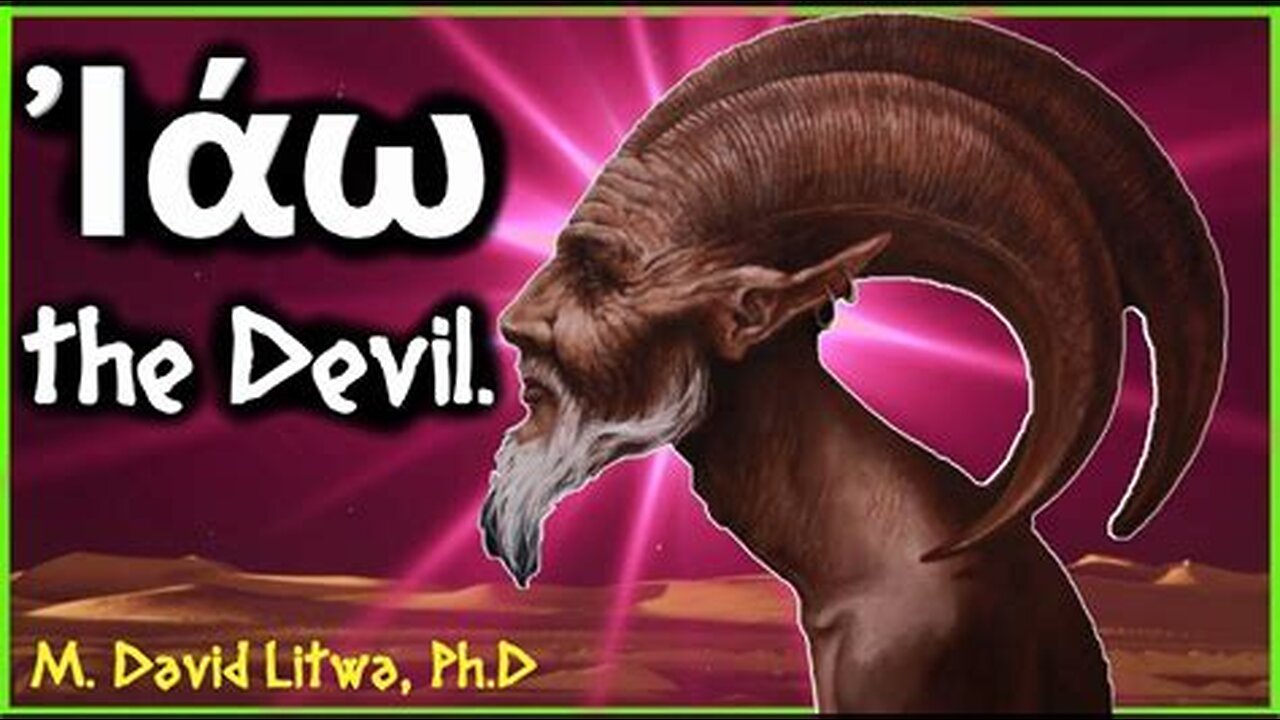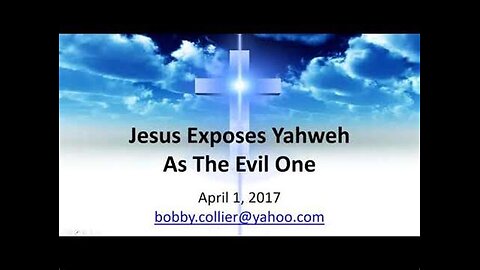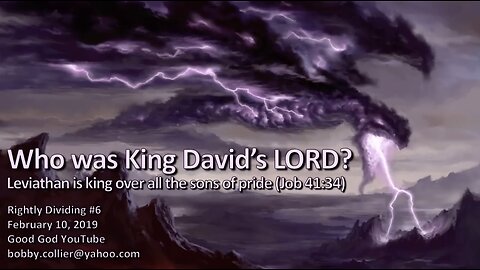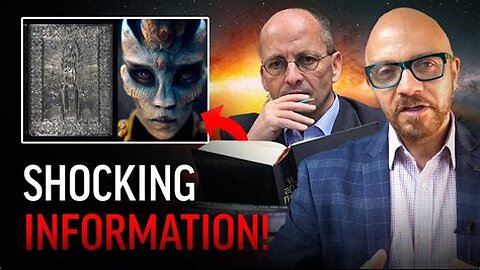Premium Only Content

Yahweh is the Beast
DID JESUS WORSHIP YAHWEH? Paul Wallis
Jesus Exposes Yahweh as the Evil One
Evidence that YHWH was a Dragon 🐉
Who was King David's god?
Early Christians: YAHWEH is Actually the DEVIL
Who is Yahweh - How a Warrior-Storm God became the God of the Israelites and World Monotheism
The Elohim - Finally We Know The Truth! Vatican Bible Translator Reveals Shocking Information
ELYON - "The Commander of The Elohim" This Information is Key! Paul Wallis & Mauro Biglino
YAHWEH | Shocking Truth Behind The Original Bible Story! Episode 3 - Paul Wallis & Mauro
WAR OF GODS | The Battle Over Project Earth - Paul Wallis & Mauro Biglino Ep 4 El Shadday
This is Huge! Portal Into The Unknown | Paul Wallis & Mauro Biglino - Bible Translations E
The Smoking Gun! The Bible is NOT About What You Think it is! Mauro Biglino & Paul Wallis
Early Christians: YAHWEH is Actually the DEVIL
In the Platonic, Neopythagorean, Middle Platonic, and Neoplatonic schools of philosophy, the demiurge is an artisan-like figure responsible for fashioning and maintaining the physical universe. The Gnostics adopted the term demiurge. Although a fashioner, the demiurge is not necessarily the same as the Creator figure in the monotheistic sense, because the demiurge itself and the material from which the demiurge fashions the universe are both considered consequences of something else. Depending on the system, they may be considered either uncreated and eternal or the product of some other entity.
The word demiurge is an English word derived from demiurgus, a Latinised form of the Greek δημιουργός or dēmiurgós. It was originally a common noun meaning "craftsman" or "artisan", but gradually came to mean "producer", and eventually "creator". The philosophical usage and the proper noun derive from Plato's Timaeus, written c. 360 BC, where the demiurge is presented as the creator of the universe. The demiurge is also described as a creator in the Platonic (c. 310–90 BC) and Middle Platonic (c. 90 BC–AD 300) philosophical traditions. In the various branches of the Neoplatonic school (third century onwards), the demiurge is the fashioner of the real, perceptible world after the model of the Ideas, but (in most Neoplatonic systems) is still not itself "the One". In the arch-dualist ideology of the various Gnostic systems, the material universe is evil, while the non-material world is good. According to some strains of Gnosticism, the demiurge is malevolent, as it is linked to the material world. In others, including the teaching of Valentinus, the demiurge is simply ignorant or misguided.
The first and highest aspect of God is described by Plato as the One (Τὸ Ἕν, 'To Hen'), the source, or the Monad. This is the God above the Demiurge, and manifests through the actions of the Demiurge. The Monad emanated the demiurge or Nous (consciousness) from its "indeterminate" vitality due to the monad being so abundant that it overflowed back onto itself, causing self-reflection. This self-reflection of the indeterminate vitality was referred to by Plotinus as the "Demiurge" or creator. The second principle is organization in its reflection of the nonsentient force or dynamis, also called the one or the Monad. The dyad is energeia emanated by the one that is then the work, process or activity called nous, Demiurge, mind, consciousness that organizes the indeterminate vitality into the experience called the material world, universe, cosmos. Plotinus also elucidates the equation of matter with nothing or non-being in The Enneads[9] which more correctly is to express the concept of idealism or that there is not anything or anywhere outside of the "mind" or nous (c.f. pantheism).
The figure of the Demiurge emerges in the theoretic of Iamblichus, which conjoins the transcendent, incommunicable “One,” or Source. Here, at the summit of this system, the Source and Demiurge (material realm) coexist via the process of henosis. Iamblichus describes the One as a monad whose first principle or emanation is intellect (nous), while among "the many" that follow it there is a second, super-existent "One" that is the producer of intellect or soul (psyche).
The "One" is further separated into spheres of intelligence; the first and superior sphere is objects of thought, while the latter sphere is the domain of thought. Thus, a triad is formed of the intelligible nous, the intellective nous, and the psyche in order to reconcile further the various Hellenistic philosophical schools of Aristotle's actus and potentia (actuality and potentiality) of the unmoved mover and Plato's Demiurge.
Gnosticism presents a distinction between the highest, unknowable God or Supreme Being and the demiurgic "creator" of the material, commonly identified as Yahweh, the God of the Hebrew Bible. Several systems of Gnostic thought present the Demiurge as antagonistic to the will of the Supreme Being: his act of creation occurs in an unconscious semblance of the divine model, and thus is fundamentally flawed, or else is formed with the malevolent intention of entrapping aspects of the divine in materiality. Thus, in such systems, the Demiurge acts as a solution to (or, at least possibly, the problem or cause that gives rise to) the problem of evil.
-
 2:02:46
2:02:46
Don't Obey
2 months agoBrave TV - Ep 1792 - The Las Vegas Shooting Assassination Attempt on Mohammed bin Salman
7.04K8 -
 5:19:50
5:19:50
SLS - Street League Skateboarding
8 days ago2024 SLS Tokyo: Women’s and Men’s Knockout Rounds
524K24 -
 2:51:00
2:51:00
Fresh and Fit
9 hours agoWomen Claim To Give Better Dating Advice So We Did THIS...
144K80 -
![[F EM UP Friday] Take # 2 [Destiny 2] Lets Kick Some A$$! #RumbleTakeOver](https://1a-1791.com/video/s8/1/c/W/7/1/cW71u.0kob-small-F-EM-UP-Friday-Take-2-Desti.jpg) 5:16:50
5:16:50
CHiLi XDD
10 hours ago[F EM UP Friday] Take # 2 [Destiny 2] Lets Kick Some A$$! #RumbleTakeOver
47K1 -
 5:13:43
5:13:43
ItsMossy
16 hours agoHALO WITH THE RUMBLERS (: #RUMBLETAKEOVER
44.5K1 -
 1:54:08
1:54:08
INFILTRATION85
10 hours agoHi, I'm INFILTRATION
39.7K9 -
 7:51:03
7:51:03
GuardianRUBY
11 hours agoRumble Takeover! The Rumblings are strong
94.3K5 -
 4:28:45
4:28:45
Etheraeon
19 hours agoWorld of Warcraft: Classic | Fresh Level 1 Druid | 500 Follower Goal
63.4K1 -
 3:17:21
3:17:21
VapinGamers
11 hours ago $3.90 earned🎮🔥Scrollin’ and Trollin’: ESO Adventures Unleashed!
43.5K2 -
 10:48:40
10:48:40
a12cat34dog
12 hours agoGETTING AFTERLIFE UNLOCKED :: Call of Duty: Black Ops 6 :: ZOMBIES CAMO GRIND w/Bubba {18+}
36.6K2












